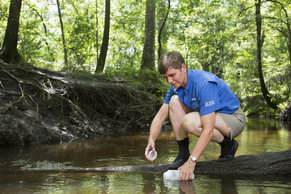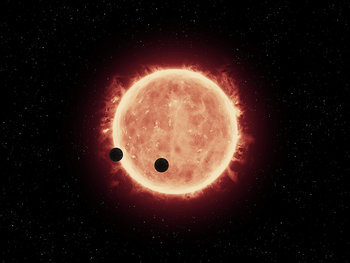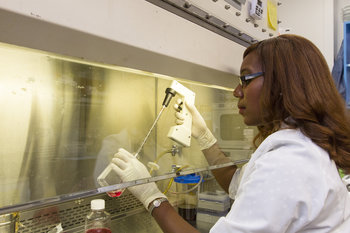
Chemical Formula | H2O |
Freezing Point &Melting Point | 0 °C (32 °F) at 1 atmosphere of pressure. Minerals and pressure can reduce this significantly. For example, seawater freezes at about −2 °C (28 °F). |
Boiling Point | 100 °C (212 °F) at sea level or 1 atmosphere of pressure. At a high altitude water boils at a lower temperature. |
Color | Pure water is colorless close up. Large bodies of water can appear blue from a distance due to Rayleigh scattering whereby water is less likely to scatter short blue wavelengths of light than longer wavelengths such as red. |
Odor | Odorless, as water is present in most air there would be no advantage to smelling it. As such, we have evolved not to smell water. |
Taste | Tasteless, this may have advantages as its tastelessness allows us to more easily taste impurities in water. |
States | Water is the only common substance to naturally exist as a solid, liquid, and gas on Earth. |
Solid State | Ice is less dense than water. As such, water expands when it freezes. This is unusual as most substances have a denser solid state. |
Solvent | Water is a universal solvent meaning that it dissolves most substances to become a solution. In fact, water dissolves more substances than any other liquid. |
Specific Heat | Specific heat is the amount of heat per unit mass required to raise the temperature of a substance by one degree Celsius. The specific heat of water is higher than any other common substance at 4.186 joule/gram °C†. As such, water tends to have a cooling effect on other substances. |
pH | Water is amphoteric meaning that it can be either an acid or a base. Rain is generally mildly acidic with a pH between 5.2 and 5.8 and can be made more acidic by pollutants such as nitrogen and sulfur oxides. |
Weight | 1 liter of water weights 1 kilogram. In United States customary units, 16 oz of water weighs a pound. |
Density | 1 gram per cubic centimeter (62 lb/cu ft). |
Compressibility | 4.6×10–10 Pa−1 at room temperature††. Water has low compressibility meaning that its volume doesn't change much at high pressure. For example, the volume of water at ocean depths of 4 kilometers, or 2.5 miles, is only reduced by about 1.8% despite pressure of 40 MPa or 5802 pound-force per square inch (psi). |
Electrical Conductivity | Pure water is an insulator. However, water is an excellent solvent and often contains dissolved minerals that make it far more conductive. The conductivity of pure water is very low at around 5.5 μS/m at room temperature. By comparison, seawater has relatively high conductivity of around 5,000,000 μS/m. Pure ice is an insulator with no measurable conductivity. |
Cohesion | Water molecules exhibit cohesion meaning that they essentially stick together. This occurs due to hydrogen bonds that are constantly breaking and forming. The cohesion of water can be viewed with simple experiments. For example, water can be added to a spoon such that the height of the water exceeds the edges of the spoon. |
Surface Tension | Water has an unusually high surface tension of 71.99 mN/m at room temperature. This is due to hydrogen bonds between water molecules. Surface tension is the reason water can hold a relatively dense object, that should sink, on its surface. |
Adhesion | Water exhibits adhesion, meaning that it tends to stick to dissimilar materials. For example, a water drop that sticks to a leaf despite gravity that should cause it to fall. |
Capillary Action | Capillary action is the ability of a liquid to flow in narrow spaces despite little or no gravity pulling it. Water exhibits high capillary action due to its cohesion and adhesion. In fact, water can flow against gravity. Plants commonly use this property to transport water up to 100 meters in the air with no mechanical force used. |
Electromagnetic Absorption | Water absorbs very little visible light but absorbs most ultraviolet light, infrared light, and microwaves. Microwave ovens make use of this property to heat food and beverages without directly heating certain types of cookware or the oven itself. |
Abundance | Water is the most abundant substance on Earth and covers 71% of the Earth's surface. It is also the third most abundant molecule in the universe. |






























